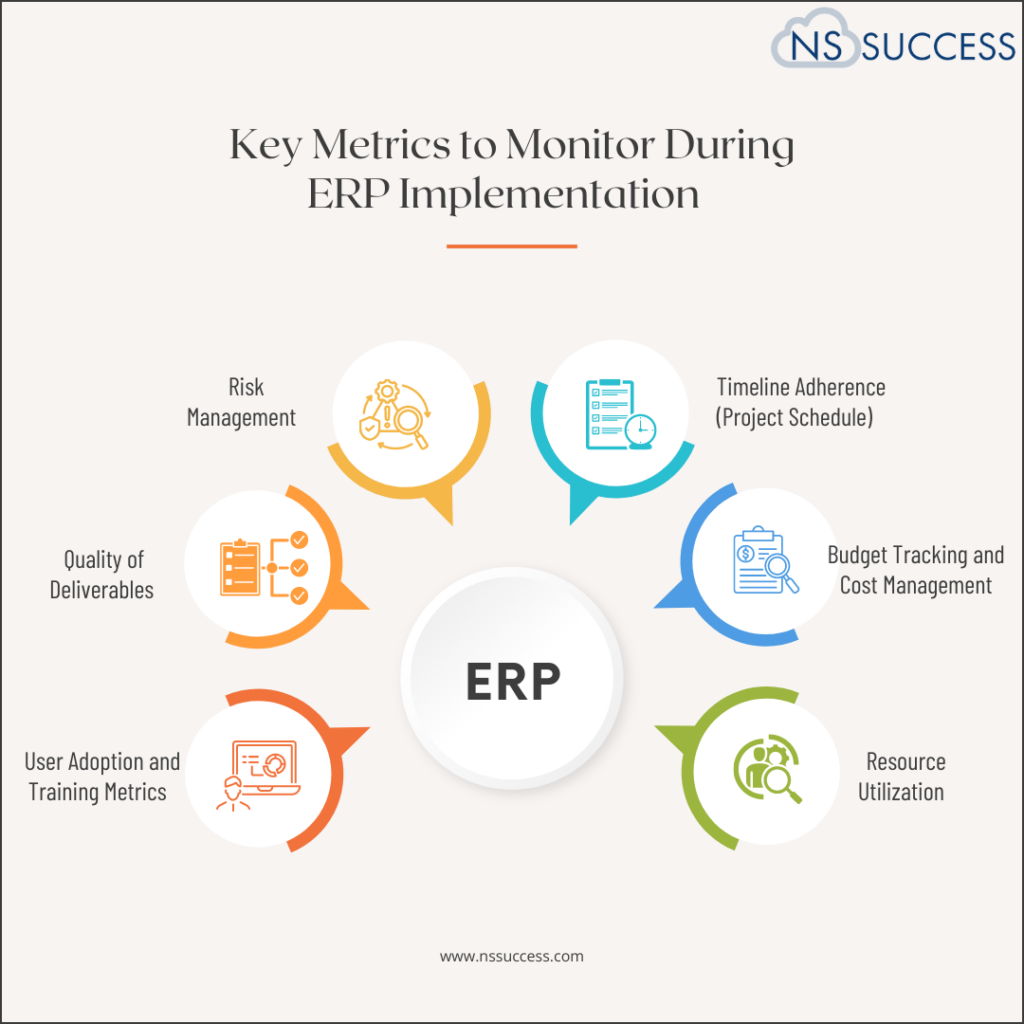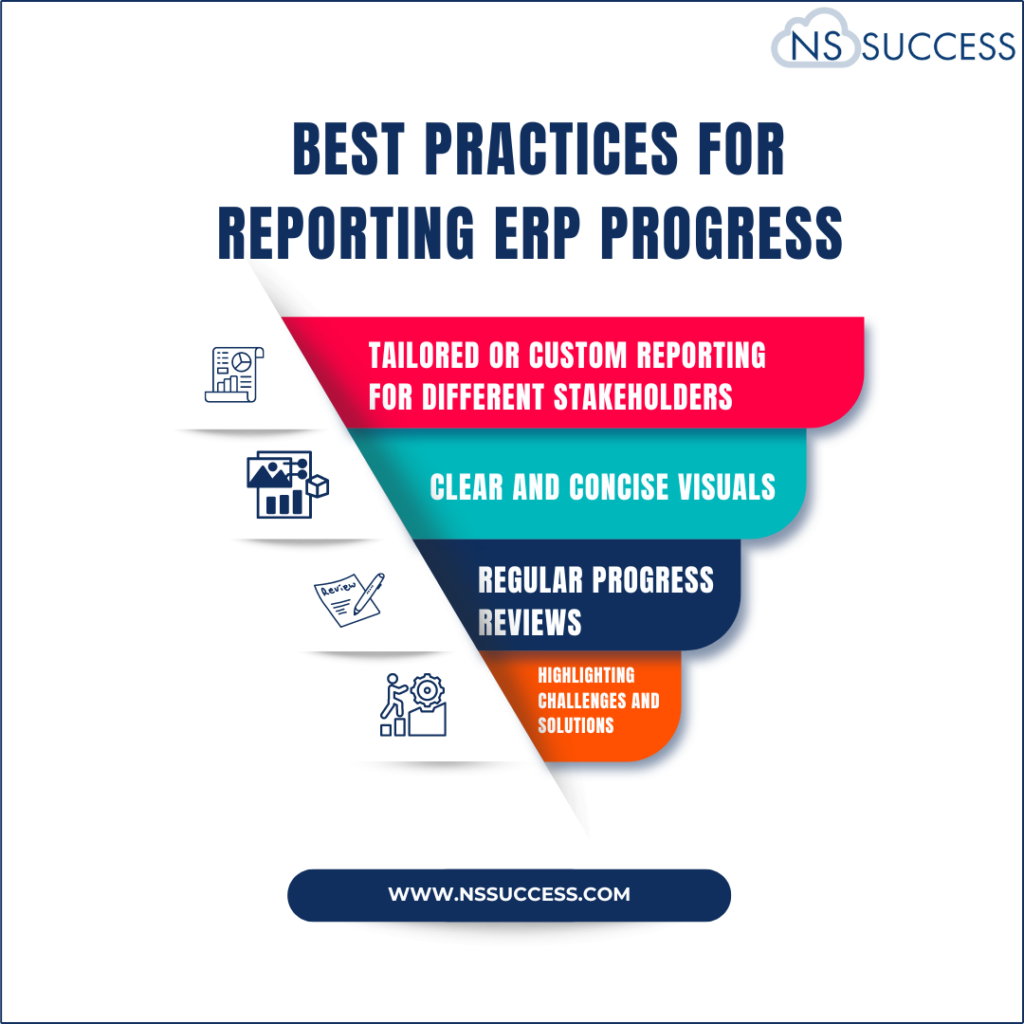Want to know how to Monitor ERP Implementation Progress? In this post, we are explaining the key Metrics for CEOs and CxOs should track during the ERP implementation. Enterprise Resource Planning (ERP) implementation is a critical and complex initiative for any business – whether you are a small company or large enterprise. CEOs and CxOs, as leaders of the organization, are tasked with overseeing this transformative process, ensuring its success while maintaining the company’s operations and financial health.

One of the most effective ways to ensure that an ERP implementation stays on track is by employing robust milestone tracking and reporting systems. But what exactly should you track, and what key metrics should CEOs, CxOs including CFOs, COOs, and CIOs focus on?
In this article, we will delve into:
1. Why Milestone Tracking is Crucial in ERP Implementation
2. Key Metrics (or parameters) to Monitor During the ERP Implementation
3. Best Practices for Reporting ERP Progress
4. How CEOs and CxOs Can Leverage These Insights for Success
1. Why Milestone Tracking is Crucial in ERP Implementation
ERP systems integrate various business functions or departments, such as finance, accounting operations, manufacturing, procurement, supply chain, and human resources, into a single cohesive system. Implementing this system is not only expensive but time-consuming and often disruptive. However, when done correctly, an ERP system can streamline operations, improve decision-making, and drive efficiency.
Milestone tracking ensures that the project stays on course and helps prevent common issues such as scope creep, budget overruns, and missed deadlines. This systematic tracking also provides a clear overview of progress, helping to align various teams and stakeholders towards common goals.
1.1 Preventing Scope Creep
Scope creep occurs when additional tasks or features are added to the project without proper evaluation of their impact. This can lead to time delays, increased costs, and project inefficiency. Tracking milestones ensures that everyone sticks to the original plan unless changes are justified and approved through a controlled process.
1.2 Ensuring Timely Deliveries
Every ERP project has a timeline, and missing deadlines can throw the entire project off track. Milestones act as checkpoints or review points that allow you to ensure that project phases are implemented as per plan and completed on time. If delays occur, tracking enables prompt action to minimize disruption.
1.3 Budget Management
An ERP implementation can be one of the most significant financial undertakings for a company. Without regular tracking of key milestones, costs can spiral out of control. Monitoring key metrics related to costs ensures that the project remains within its allocated budget.
2. Key Metrics to Monitor During ERP Implementation
ERP implementation involves various moving parts, and certain metrics provide a clear indication of project health. For CEOs and CxOs, focusing on the right metrics ensures that you can address issues early and keep the project on track.
Here are the key metrics to monitor:
2.1 Timeline Adherence (Project Schedule)

Adhering to the project timeline is critical for a successful ERP implementation. Track whether key milestones are being met on time.
Key performance indicators (KPIs) to watch include:
- Percentage of tasks completed on schedule – A delay in critical path tasks can cause a domino effect, impacting the entire project.
- Task slippage – If tasks are being delayed, how many days are they overdue, and what is the impact on the overall project?
Regularly monitoring these KPIs can help address delays before they turn into larger issues.
2.2 Budget Tracking and Cost Management
ERP implementation costs can quickly escalate if not properly controlled. CEOs and COOs need to have a firm grasp on the financial side of the project. Cost metrics include:
- Budget variance – Are you spending more or less than initially planned? Monitoring both over and under-spending is critical.
- Cost performance index (CPI) – CPI is a ratio that is typically used in project monitoring to measure the value of the work completed against the actual cost incurred. A CPI of less than 1 indicates that there is a cost overrun, while a CPI greater than 1 suggests that your project is within the budget.
Staying on top of cost metrics ensures that you avoid unexpected financial strain on the company.
2.3 Resource Utilization
Inefficient use of resources—whether it’s human capital, hardware, or software—can derail an ERP project. Metrics to monitor include:
- Team workload balance – Are key personnel overloaded or underutilized? Monitoring how work is distributed among your team can help you reallocate resources more effectively.
- Resource allocation – Ensure that the necessary resources (people, time, equipment) are available when they’re needed for each project phase.
Efficient resource allocation ensures that the project remains efficient and doesn’t burn out key personnel.
2.4 User Adoption and Training Metrics
No ERP system can succeed without buy-in and proper use by the staff. Monitoring user adoption is crucial. Metrics to focus on include:
- Training completion rates – How many employees out of the total have completed the required training programs?
- User feedback – Are employees satisfied with the training and the ERP system itself?
An ERP system is only as good as the people or users who are using it. If adoption rates are low, the system won’t deliver its full potential.
2.5 Quality of Deliverables
The quality of the work delivered is a key success factor in ERP implementations. As part of milestone tracking, ensure you are measuring:
- Defect rates in project deliverables – Are the solutions being deployed meeting the necessary quality standards?
- Rework levels – High levels of rework indicate that project requirements aren’t being met, or quality is slipping.
By ensuring high-quality deliverables at each phase of the project, you reduce the risk of future issues and ensure a smoother transition.
2.6 Risk Management
ERP implementations carry inherent risks, such as integration challenges, data migration issues, or vendor problems. Metrics to track include:
- Identified risks vs. mitigated risks – Are the risks identified being properly managed and mitigated?
- Risk severity levels – Track the impact of risks, categorizing them into low, medium, or high severity to prioritize attention.
Proper risk management helps avoid sudden surprises and ensures the project moves forward smoothly.
3. Best Practices for Reporting ERP Progress
Reporting on ERP implementation progress involves more than just ticking off milestones. The reports must provide valuable insights to executives, highlighting both successes and challenges.

3.1 Tailored or Custom Reporting for Different Stakeholders
Your reporting structure should cater to the needs of different audiences. CEOs may only need high-level overviews, while the project team requires detailed reports. Key report types include:
- Executive summary reports – High-level progress reports for CEOs and CxOs, focusing on key metrics like budget, timeline, and risk.
- Detailed project reports – In-depth reports for the project team detailing task-level progress, issues, and next steps.
Customizing the level of detail ensures that each stakeholder has the information they need without being overwhelmed.
3.2 Clear and Concise Visuals
Using visuals such as Gantt charts, progress bars, and pie charts makes complex data easier to understand. CEOs and CxOs need to be able to grasp key insights quickly. Some useful visual tools include:
- Gantt charts – These help visualize the timeline of the project, showing how different tasks interrelate and highlighting any bottlenecks.
- Budget vs. actual spend charts – A bar chart that contrasts planned versus actual spending can be a powerful way to see budget performance at a glance.
3.3 Regular Progress Reviews
ERP projects can sometimes take months or even years to complete. Regular reviews ensure that progress remains consistent. A good rule of thumb is to have monthly reviews for larger milestones and weekly or biweekly updates for smaller tasks.
3.4 Highlighting Challenges and Solutions
Don’t shy away from highlighting challenges in your progress reports. However, always couple problems with potential solutions or plans for resolution. This proactive approach builds confidence in leadership and the project team.
4. How CEOs and CxOs Can Leverage These Insights for Success
Tracking and reporting ERP implementation milestones isn’t just about keeping tabs on progress—it’s a tool for leadership to steer the project toward success. Here’s how CEOs and CxOs can leverage the insights gained from these metrics:
4.1 Strategic Decision Making
By regularly reviewing key metrics, executives can make more informed decisions about resource allocation, project scope, and timelines. If a particular phase of the project is falling behind, leadership can decide whether to allocate more resources or adjust the timeline.
4.2 Financial Oversight
Cost overruns are a major risk in ERP projects. Monitoring budget-related metrics allows CEOs and CxOs to spot early warning signs and take corrective action before the company’s finances are negatively impacted.
4.3 Risk Mitigation
By focusing on risk management metrics, executives can stay ahead of potential roadblocks and mitigate them before they escalate. This proactive approach reduces the likelihood of project failure.
4.4 Ensuring LongTerm Success
Tracking user adoption and training completion ensures that the ERP system is set up for long-term success. It’s not just about installing new software; it’s about making sure your workforce is ready to use it effectively.
Final words
ERP implementation is a significant undertaking, requiring detailed milestone tracking and consistent reporting. For CEOs and CxOs, the ability to monitor key metrics such as timeline adherence, budget tracking, resource utilization, and user adoption is essential to project success. By employing these tools and practices, executives can ensure that the ERP project stays on track, within budget, and delivers the intended value to the organization. Successful ERP implementation can transform a company, making operations more efficient, data-driven, and scalable. With the right tracking and reporting systems in place, CEOs and CxOs can guide their organizations through this transformation confidently and effectively. If you are evaluating an ERP solution for your organization – connect with our team for our Oracle NetSuite ERP Implementation Services. Our team can help you right from the initial stage and can also help you effectively monitor the ERP implementation.

 “NS Success” is the NetSuite Consulting Practice of Dhruvsoft Services Private Limited – a leading NetSuite Solution Provider Partner from India – providing services worldwide …
“NS Success” is the NetSuite Consulting Practice of Dhruvsoft Services Private Limited – a leading NetSuite Solution Provider Partner from India – providing services worldwide …